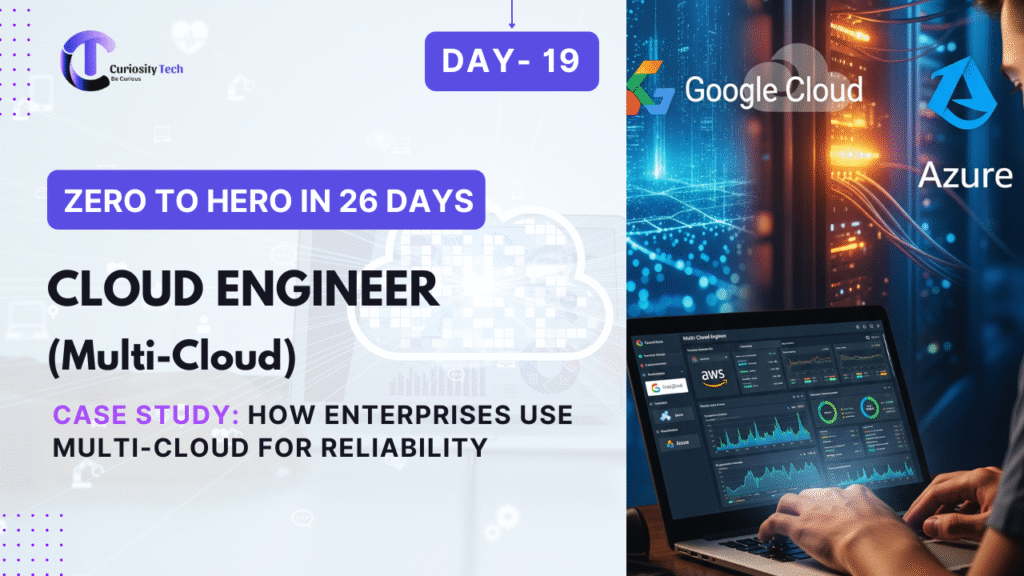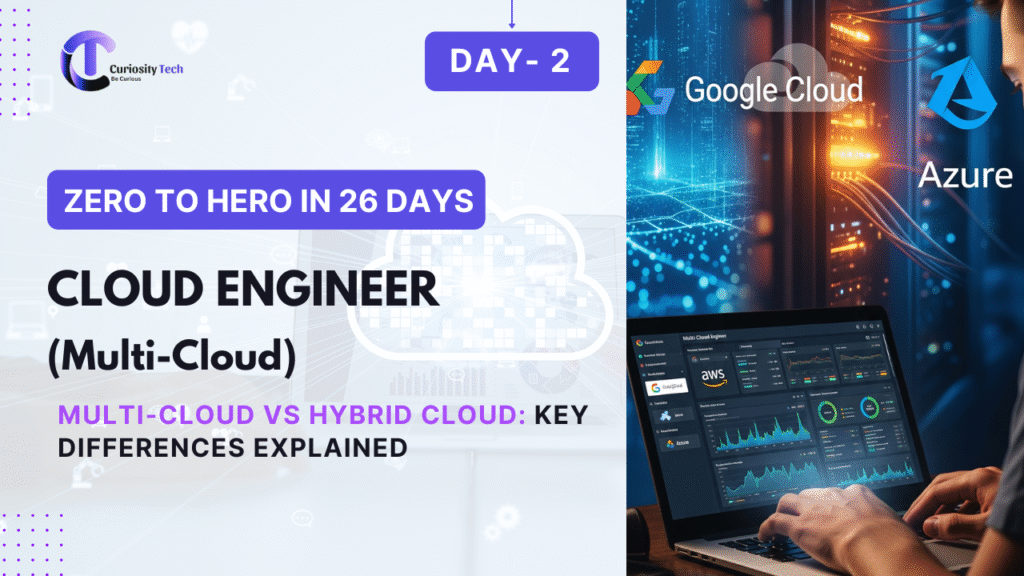Introduction
Multi-cloud strategies promise flexibility, resilience, and scalability, but they also introduce complexity and risk.
Many enterprises fail to achieve the expected benefits because of avoidable mistakes — spanning architecture, governance, cost management, security, and operations.
At CuriosityTech.in, our multi-cloud labs emphasize learning from mistakes before they impact production. Engineers simulate failures, misconfigurations, and cost overruns in controlled environments, developing practical wisdom.
Section 1 – Mistake 1: Lack of Unified Governance
Problem:
● Each cloud provider has its own IAM, policy tools, and compliance frameworks.
● Enterprises often implement siloed governance → inconsistent security and policy enforcement.
Impact:
● Increased risk of unauthorized access.
● Regulatory fines due to non-compliance.
Mitigation:
● Adopt a centralized governance model.
● Use policy-as-code frameworks: Terraform + Sentinel, Crossplane, Cloud Custodian.
● Hierarchical governance diagram (described):
○ Top Layer: Enterprise policies (GDPR, HIPAA, PCI DSS).
○ Middle Layer: Cloud-specific enforcement.
○ Base Layer: Automated monitoring & compliance checks.
CuriosityTech Labs: Engineers simulate cross-cloud IAM misconfigurations and practice correcting them in real-time.
Section 2 – Mistake 2: Poor Cost Management
Problem:
● Multi-cloud can double or triple costs if resources are unmanaged.
● Common issues: idle VMs, overprovisioned storage, cross-region data transfer.
Impact:
● Escalating cloud bills, ROI not achieved.
● Difficulty in forecasting budgets.
Mitigation:
● Use cost management platforms: CloudHealth, Kubecost, CloudCheckr.
● Automate resource shutdown and scaling policies.
● Regular audits of cloud usage and cost allocation.
Example: A retail enterprise running test instances on AWS and Azure simultaneously incurred $50,000/month in idle costs before implementing automated scaling.
Section 3 – Mistake 3: Ignoring Network & Latency Challenges
Problem:
● Cross-cloud traffic without proper planning → high latency, packet loss, or security exposure.
Impact:
● Application performance degradation.
● Poor end-user experience.
Mitigation:
● Plan hybrid/multi-cloud network architecture: VPN, VPC peering, Direct Connect / ExpressRoute / Interconnect.
● Use CDN & edge caching for latency-sensitive applications.
● CuriosityTech labs teach engineers to simulate multi-region, multi-cloud network latency scenarios and optimize routing.
Section 4 – Mistake 4: Inadequate Security Posture
Problem:
● Multi-cloud security is complex: each provider has its own threat model.
● Common mistakes: misconfigured S3/Blob buckets, weak IAM policies, unsecured secrets.
Impact:
● Data breaches, compliance violations.
● High remediation costs.
Mitigation:
● Adopt Zero Trust Security Model across clouds.
● Centralize secrets management (Vault, Azure Key Vault, GCP CMEK).
● Implement continuous security monitoring (Prisma Cloud, CloudGuard, GuardDuty).
Section 5 – Mistake 5: Lack of Observability & Monitoring
Problem:
● Multi-cloud deployments without unified observability → blind spots in performance and availability.
Impact:
● Missed SLA violations.
● Slow incident response.
Mitigation:
● Implement centralized observability: Datadog, Prometheus + Grafana, Splunk.
● Standardize logging, metrics, and tracing across providers.
● Labs simulate cross-cloud outage scenarios to train engineers in rapid detection and resolution.
Section 6 – Mistake 6: Overlooking Disaster Recovery & High Availability
Problem:
● Multi-cloud strategies sometimes neglect proper DR/HA planning.
Impact:
● Downtime during regional failures.
● Data loss and customer dissatisfaction.
Mitigation:
● Deploy active-active or active-passive failover architectures.
● Replicate critical workloads across regions and providers.
● Test DR scenarios in controlled environments (CuriosityTech labs).
Section 7 – Common Mistakes & Mitigation Table
| Mistake | Impact | Mitigation | Tools / Labs |
| Lack of unified governance | Unauthorized access, non-compliance | Policy-as-code, hierarchical governance | Terraform, Sentinel, Crossplane, CuriosityTech labs |
| Poor cost management | Escalating bills | Automated scaling, audits, cost tools | CloudHealth, Kubecost, CloudCheckr |
| Ignoring network latency | Poor app performance | Multi-cloud network design, CDN | VPN, VPC Peering, Direct Connect / Interconnect |
| Weak security | Data breaches | Zero Trust, secrets management, monitoring | Vault, GuardDuty, Prisma Cloud, CloudGuard |
| Lack of observability | SLA violations, slow response | Centralized logging & metrics | Datadog, Prometheus, Grafana, Splunk |
| Neglecting DR/HA | Downtime, data loss | Active-active/active-passive setups | Multi-region replication, CuriosityTech labs |



